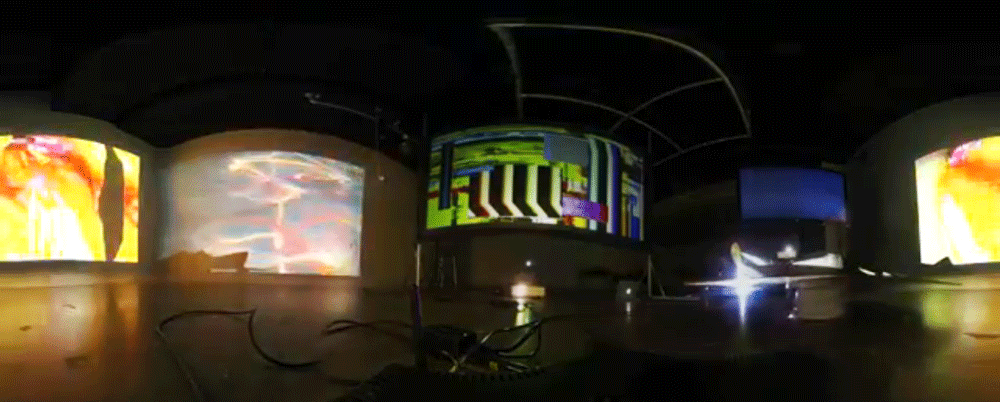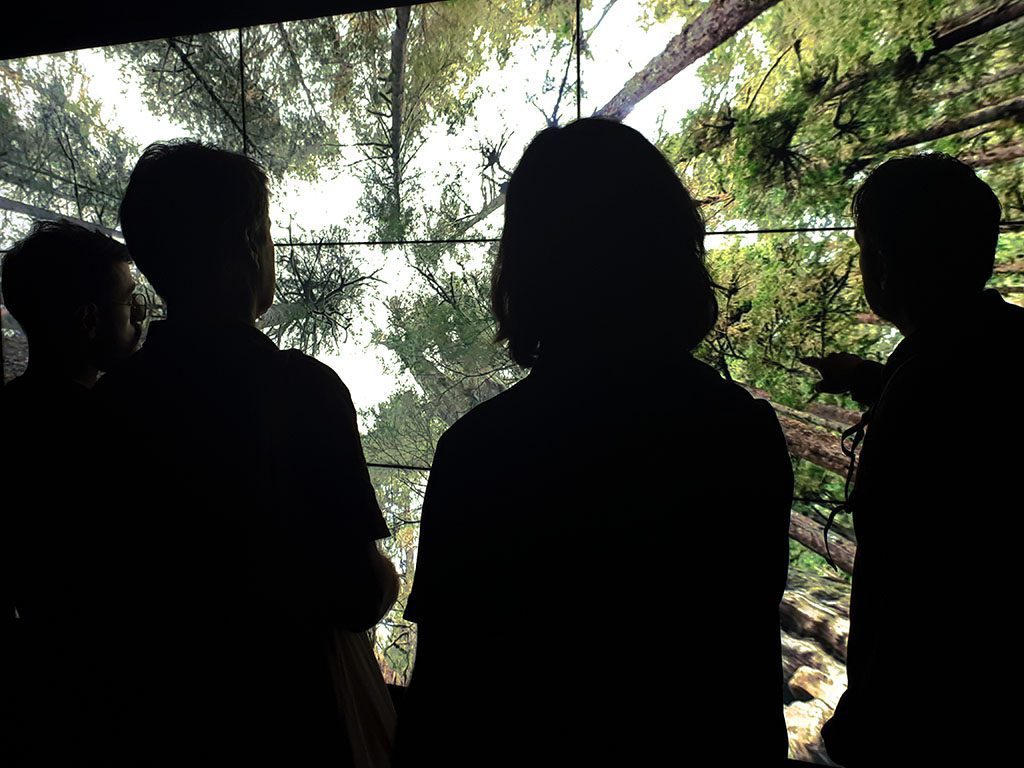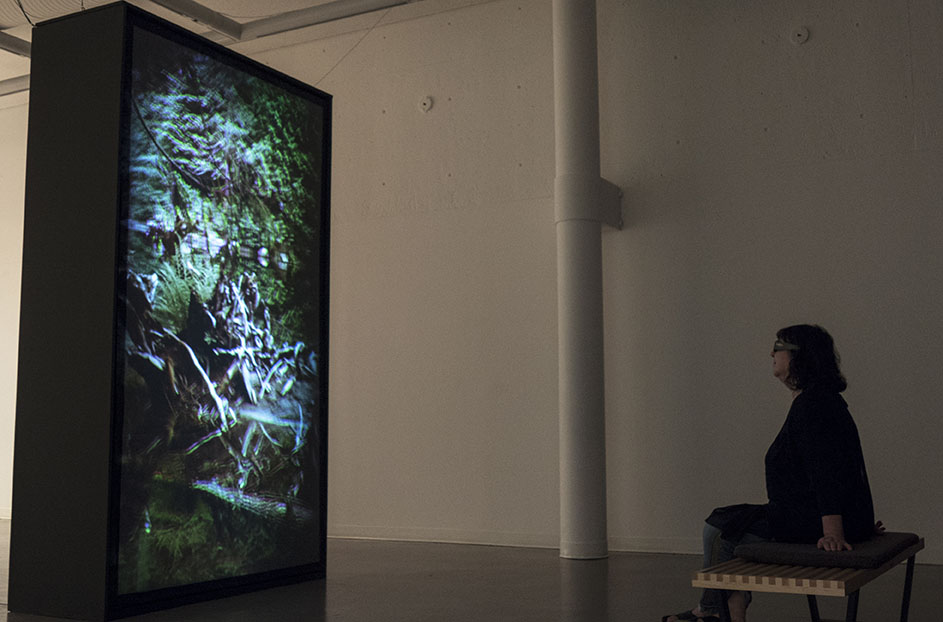Author: Ana ferguson (Page 2 of 3)
GALA – July 23–30, 2018
This July 23- 30th Concordia University is pleased to host both a conference and an International Graduate Summer School in partnership with GALA.
The Global Academy of Liberal Arts (GALA) is a select international community of institutions, faculties, programmes, and research centres that seeks to develop new kinds of research and teaching collaboration, to support enhanced international mobility among staff and students, and to reimagine liberal arts education for the twenty-first century.
This event will be featuring three of our Elastic Spaces members, Anthony Head, Gary Sangster, and Leila Sujir.
Schedule:
July 27
11:00 – 12:30 – Sensations, Spaces, and Spectacles: Shaping Experience for Audiences, Now and in the Future – Gary Sangster (Bath Spa)
13:30 – 15:00 -Co-Creation and the Public Role of Liberal Arts: Workshop developing a single piece of digital media, and an associated description or reflection, intended to make their research accessible to public audiences and highlight an important social issue – Anthony Head and Leila Sujir
For more information check out the link below:
http://www.concordia.ca/artsci/academics/summer/GALA2018/GALA-Conference.html
CanadianArt: Into the Woods
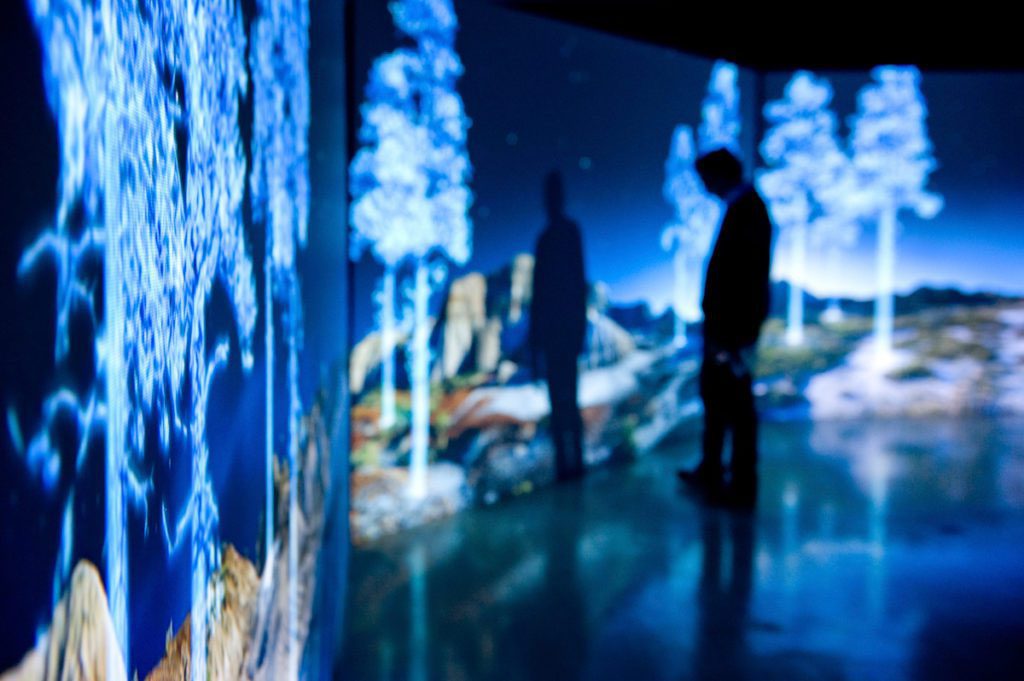 Kelly Richardson, The Erudition (2010). Installation view at NGCA UK. 3 screens, 48 feet x 9 feet; HD video with sounds, 20 minute loop. Courtesy of the artist and Birch Contemporary. Photo: Colin Davison.
Kelly Richardson, The Erudition (2010). Installation view at NGCA UK. 3 screens, 48 feet x 9 feet; HD video with sounds, 20 minute loop. Courtesy of the artist and Birch Contemporary. Photo: Colin Davison.
“Supernatural: Art, Technology and the Forest” at the Art Gallery of Greater Victoria seems less intended to provide directives than to register tensions. Curator Haema Sivanesan indicates gestures of connection without becoming explicitly political, while upholding a sense of reverence that accommodates moments of both open-endedness and opacity.
A powerful introduction to the show, Kelly Richardson’s three-screen video installation The Erudition (2010) presents a nocturnal hoodoo landscape haunted by twitching holographic trees. This film-negative aesthetic, recalling the spectral landscapes of Peter Doig, evokes both intimacy and unease: a state of being not-at-home at home.
Contrasting with The Erudition’s atmospheric ambiguity are geographically specific works in which forest composes both site and archive.
Ian Wallace’s Clayoquot Protest series (1993–95) presents large photographs of the historic protest, featuring acrylic-print insets of woodgrain cross-sections.
A nearby monitor screens Bones of the Forest (1995) by Heather Frise and Velcrow Ripper; this documentary features First Nations Elders, alternative loggers and corporate apologists, spliced together in a nod to punk’s DIY ethos.
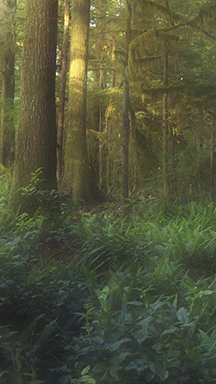 Leila Sujir, Forest Breath, 2018. Stereographic 3D video Projection; 5 minute loop. Cinematographer: Christian Kroitor.
Leila Sujir, Forest Breath, 2018. Stereographic 3D video Projection; 5 minute loop. Cinematographer: Christian Kroitor.
Leila Sujir’s Forest Breath (2016–ongoing), a differing vision of collective texture, is a stereoscopic video installation proffering live feed as porous tableau: tactile gaps in the matrix of limb, vine, twig and mulch mingle to the drone of overlapping sine waves. (Sujir’s live feeds have often featured Vancouver Island’s Walbran Valley, which is slated for clear-cutting.)
This contrast—between document as frame and forest as continuum—continues in the video How to climb a tree (2017) by photographer and video artist Sandra Semchuck and performance artist Ayumi Goto. Offering abstract homage to Squamish carver Robert Yelton, Goto moves through forested space in a dance aligned with Semchuk’s continuo of overtone singing.
Semchuck’s practice is also represented by a series of landscape photographs overlaid with text. The relentless density of Semchuk’s settings—all middle ground—and the ambiguity of the speaker or listener in the texts allow for an intersubjective approach that moves beyond genre.
Further gambits of perspective and identity take place in artist-anthropologist Trudi Lynn Smith’s work, Drift Camera (2015–ongoing). Halfway between a camera obscura and a wearable tent, this structure is suspended to form a cave-like recess from which a single viewer gazes out at driftwood that Smith dubs, “a fugitive forest.”
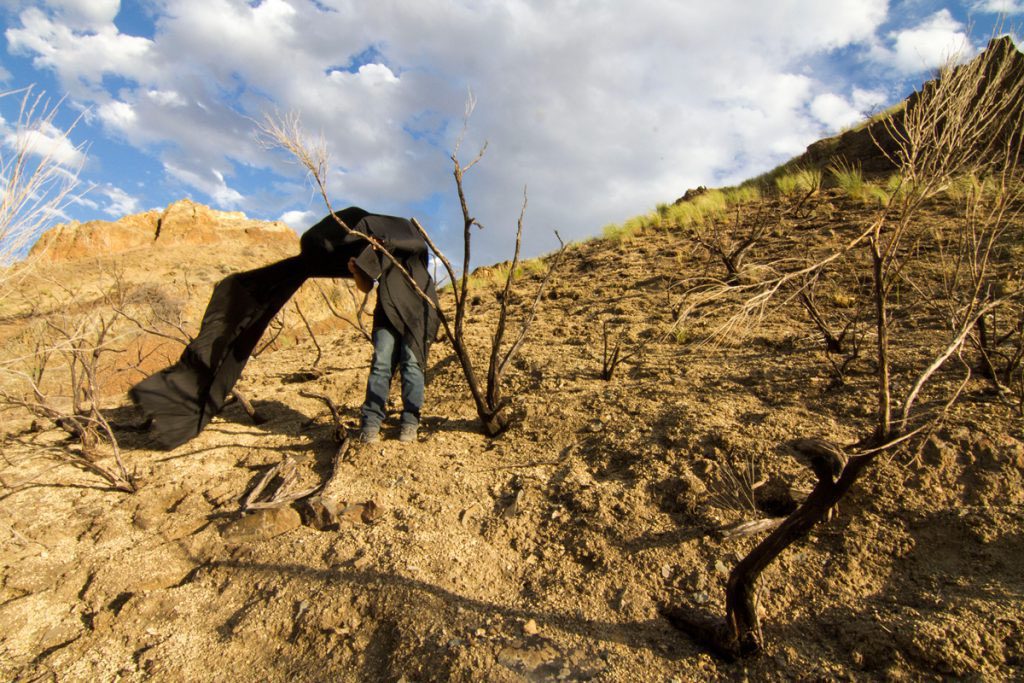 Trudi Lynn Smith, Breath Camera — prototype 1, 2015–ongoing. Documentation of the camera being used in field-based research into contested territories/burned landscapes, 2016. Darkcloth (velvet and cotton), hand-built camera (suede, bellows, optical lenses, screen material); dimensions variable. Courtesy of the artist.
Trudi Lynn Smith, Breath Camera — prototype 1, 2015–ongoing. Documentation of the camera being used in field-based research into contested territories/burned landscapes, 2016. Darkcloth (velvet and cotton), hand-built camera (suede, bellows, optical lenses, screen material); dimensions variable. Courtesy of the artist.
Transformation via camera is at hand in two other photo series: Dan Siney’s Stump 1, 2, 3(2008) and Rodney Graham’s Study (5 Polaroids from Series: 75 Polaroids) (1976). Siney’s anthropomorphized stumps are the result of loggers cutting eye-like notches into trees for springboards before cutting. Blurrily monumental, they are accidental votives in a state of fertile decay. Graham’s pictures, likewise, make strange a kind of lark: a walk through the forest at night with a Polaroid camera. Tantalizingly hermetic, his images stage a provocative vanishing act.
Carol Sawyer’s Woodwork (2011) consists of seven short videos made from archival footage of the logging industry. The truncated videos develop a metanarrative: fragments of an epic depicting epic fragments.
Mike Andrew McLean’s series JR (2015–ongoing) documents the ongoing narrative of “ghost town” Jordan River, northwest of Victoria. In 2014, residents were told that the combination of a nearby dam and seismic activity meant the threat of sudden flood in the event of an earthquake, an apocalyptic prophecy that loomed large for the artist as he traversed these remnants of the town with his large-format camera. Notable is his use of scarce Kodak Aerochrome film, developed for military and surveying aerial photography, which tints organic material in hues of pink and crimson, summoning counterpoints as richly varied as Frederick Edwin Church, Walt Disney, Richard Mosse and Edward Burtynsky.
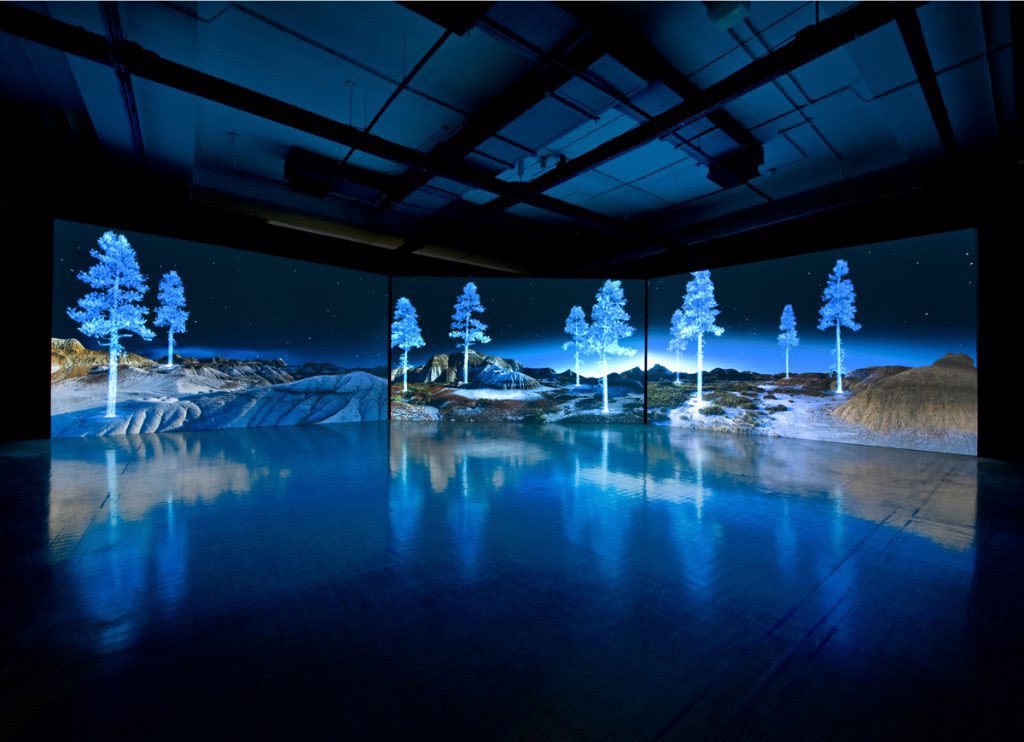 Kelly Richardson, The Erudition (2010). Installation view at NGCA UK. 3 screens, 48 feet x 9 feet; HD video with sounds, 20 minute loop. Courtesy of the artist and Birch Contemporary. Photo: Colin Davison.
Kelly Richardson, The Erudition (2010). Installation view at NGCA UK. 3 screens, 48 feet x 9 feet; HD video with sounds, 20 minute loop. Courtesy of the artist and Birch Contemporary. Photo: Colin Davison.
A defining non-feature of “Supernatural” is its absence-as-presence of Indigenous voices. With its focus on photo-based media, the story of the forest presented here is one of Cartesian colonial methodologies: capture, extraction, taxonomy and commodity. This point is underscored by the accompanying exhibitions in the gallery: “Form as Meaning,” a survey of Indigenous printmakers, and “Picturing the Giants,” a show of Emily Carr’s work in dialogue with pieces by contemporary First Nations artists like Sonny Assu and Lindsay Delaronde, among others.
Between these exhibition offerings, indigeneity is performed in varied guises, transposing itself and reorienting its audience, with the forest—home (for some) to formlessness, and at the very least, home to phenomena that elide photographic capture—as informal host.
John Luna is a poet, critic and visual artist whose practice includes painting and installation, and a teacher working in the areas of art and art history. He is based on Vancouver Island.
https://canadianart.ca/reviews/supernatural-art-technology-and-the-forest-aggv/
Photo Credit: Jorge Zavagno
Artists Explore the Forests and What Lies Ahead
by Mike Devlin/ Times Colonist
May 17, 2018 06:00 AM
EXHIBITION
What: Supernatural: Art, Technology and the Forest
Where: Art Gallery of Greater Victoria, 1040 Moss St.
When: Saturday through Sept. 3
Admission: $13 (adults), $11 (seniors and students), $2.50 (ages 6 to 17); children five and under are free
Information: 250-384-4171 or aggv.ca
Note: Admission on May 19 is free from 10 a.m. until 5 p.m.
The junction where technology meets the environment has become an uneasy meeting point in the modern era. A bygone phrase about ecological conservation — “Take nothing but pictures, leave nothing but footprints, kill nothing but time” — would suggest humankind’s need to dig deeper into the biosphere runs contrary to the ecosystem ethos. On the other hand, how do we learn about the environment without studying it?
That’s what a new exhibit at the Art Gallery of Greater Victoria is attempting to answer. Supernatural: Art, Technology and the Forest, which opens Saturday and runs through Sept. 3, is a multi-media presentation that uses videos, photos, and computer-generated images to examine the forests of B.C.
The goal is to better understand the forest and how human interaction with it will adjust, according to exhibit curator Haema Sivanesan.
“People have always lived with and alongside the forest,” Sivanesan said. “If we look at Indigenous histories and go back further than our modern idea of what the forest is, we’ve always had a relationship to forests and forest landscapes. Maybe this [exhibit] is trying to think through some of those bigger questions.”
There is an underlying sense of inspiration about the exhibit, one that can be encapsulated by 19th- century philosopher Henry David Theroux: “It’s not what you look at that matters, it’s what you see.”
Sivanesan loves what Supernatural: Art, Technology and the Forest offers in that regard. “It’s looking at how artists are using new technologies, and a lot of that is camera-based technology, whether it’s as simple as digital photography or 3D video. All of it has to do with a camera, in some way, and how they are using that to look at the forest in a new way.”
Eight Canadian artists (Mike Andrew McLean, Kelly Richardson, Carol Sawyer, Trudi Lynn Smith, Sandra Semchuk, Dan Siney, Leila Sujir and Ian Wallace) and one collaborative team (Ayumi Goto and Sandra Semchuk) are participating. Their art ranges in tone and medium, from Richardson’s computer-generated imagery with sound that takes up a whole room of the gallery to Sujir’s blackbox-style Imax 3D captures of the Walbran forest.
“It’s very compelling because it’s working between the two genres,” Sivanesan said of Montreal-based Sujir’s work. “We’ve all looked at photos from very famous photographers like Ansel Adams, who’ve taken pictures of national parks and forests we are very familiar with. Because of this new technology, it’s allowing artists to do different things and understand the forest in new ways.”
The contributions of Victoria artist Trudi Lynn Smith are of particular note. Her “Breath Camera,” a hand-built prototype housed in suede, presents what the viewer sees in tandem with what they feel while immersed in a camera-form cloak. Smith serves as a guide, shepherding the participant through a journey using only lenses from an old optician’s kit — to play with reality through what she calls “noticing.”
“It is meant to show how simple it was to build a camera and how difficult it is to take a photograph,” Sivanesan said of Smith’s installation. “It has more to do with making us think about how we look at the world. Everybody has a cellphone these days and it’s so easy to just snap a picture. This is talking about the complexities of that.”
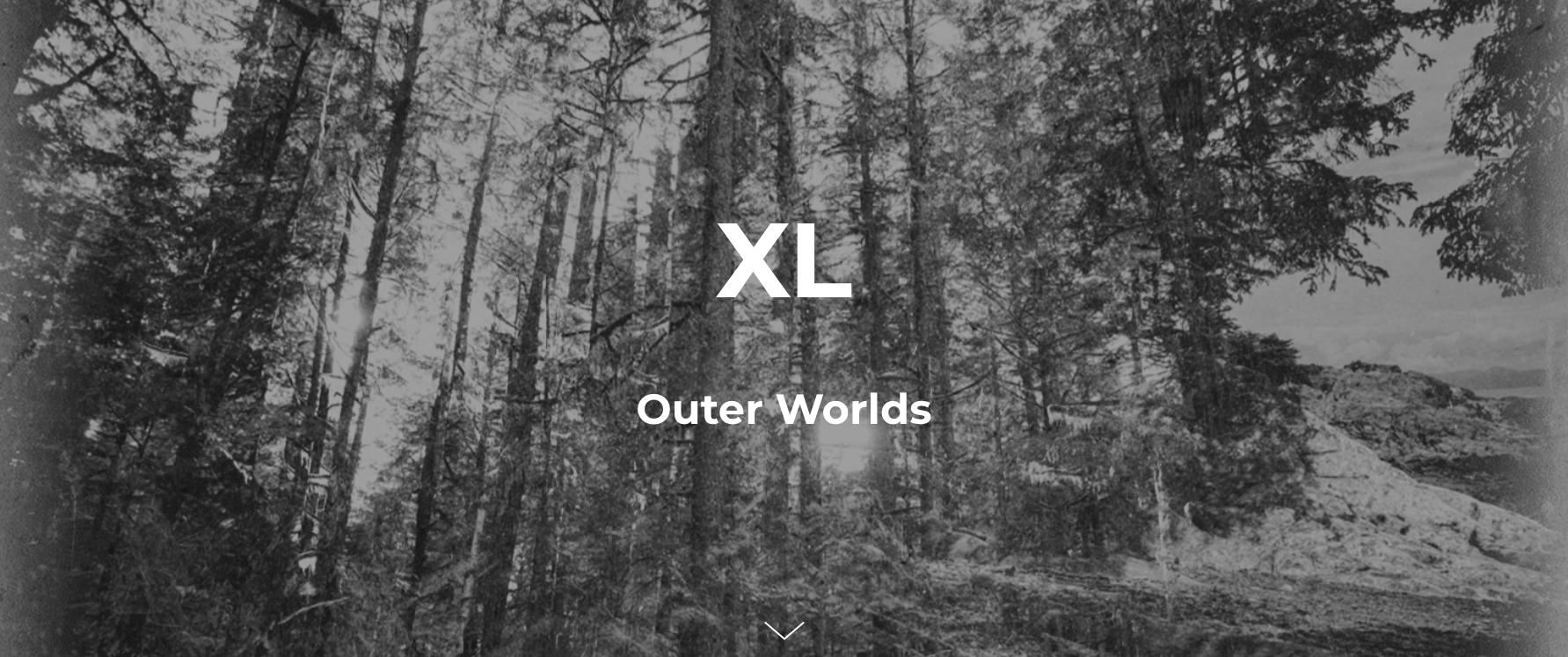
In celebration of the 50th anniversary of the invention of IMAX Janine Marchessault of the Public Access Collective and Christian Kroitor (grandson of IMAX inventor Roman Kroitor) of True Frame Productions have come together to commission five new large-format digital film shorts as part of a three- day festival in 2019. The festival will take place at the Cinesphere, the world’s first permanent IMAX movie theatre located in Toronto at Ontario Place. The theme of the program in true IMAX form, centres around the larger-than-life landscape that forms an outer world. The festival will include works by Canadian artists: Oliver Husain, Lisa Jackson, Kelly Richardson, Michael Snow, and Leila Sujir.
The festival is aimed at celebrating the invention of IMAX by showcasing the commissioned films alongside a selection of early IMAX productions. The XL-Outer Worlds festival is expected to later tour the first IMAX cinemas across Canada in Victoria, Sudbury, Edmonton and Montreal.
This project was funded through the Canada Council for the Arts’ New Chapter program.
For more information check out the link below:
Or check out the announcement made by Canadian Art:
https://canadianart.ca/news/news-brief-museum-show-justin-bieber/
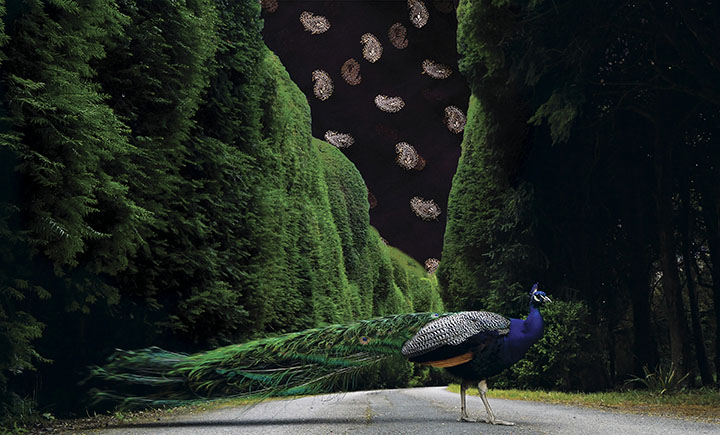
We’re please to announce FotoFest’s publication launch INDIA/Contemporary Photographic and New Media Art as part of the FotoFest 2018 Biennial in Houston, Texas happening this March 10–April 22, 2018. The publication features images, statements, and biographies from participating artists within the festival, including Elastic Spaces’ Leila Sujir! The book will be available worldwide beginning in March.
Check out the link for more information:
http://www.e-flux.com/announcements/167958/india-contemporary-photographic-and-new-media-art/
For a list of all participating artists check out the link just released by ArtNews
http://www.artnews.com/2017/12/18/fotofest-international-reveals-artist-list-2018-edition/
During the Elastic Spaces Third International Symposium at Bath Spa University, Santiago Tavera, Ana Ferguson, Francisco Gonzalez and Philippe Battikha collaborated on a VR live broadcast session titled, Virtual Narratives of Dislocation. Together they constructed a virtual environment that simulates experiences of multimedia dislocation. This interdisciplinary project investigates notions of digital re-presentation, virtual translation, cultural narratives, media illusion and spatialized sound. The project consists of using the Orah 4i- 360° camera to digitally broadcast live an audiovisual immersive installation from the Newton Park Campus at Bath Spa University, UK. Participants at the conference were invited to be part of this work during the two hour session by entering the space to experience it but also to look at it through their mobiles devices. One as a 360° video to be navigated by scrolling the video image to every side. The second method of viewing the work using participant’s phones was by using a google cardboard head sets to experience the work as VR. Seeing themselves being and seeing all at once. In its entirety, the project combines narratives of belonging and displacement with experimental VR and digital techniques to forge an intersection between personal experiences of dislocation, the construction and experiencing of virtual environments and the narratives that emerge within them.
